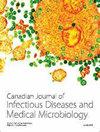浙江省有过性行为的男大学生HIV检测相关因素分析
IF 2.6
4区 医学
Q3 INFECTIOUS DISEASES
Canadian Journal of Infectious Diseases & Medical Microbiology
Pub Date : 2023-11-13
DOI:10.1155/2023/6646210
引用次数: 0
摘要
目标。本研究旨在了解浙江省有过性行为的男大学生艾滋病病毒检测的流行情况,了解影响HIV检测的因素,为预防和控制校园艾滋病病毒感染提供科学依据。方法。进行分层整群随机抽样分析,包括一般特征、性态度、性行为、艾滋病毒检测信息和艾滋病毒感染自我风险评估。采用单因素和多因素logistic回归分析确定影响因素。结果。在2734名有过性行为的男学生中,319人(11.7%)在上一年接受过艾滋病毒抗体检测。多变量分析结果显示,初二年级(调整优势比(AOR) = 1.59, 95%置信区间(95% CI): 1.10-2.30)的参与者表现出对男性同性恋行为的接受度(AOR = 1.73, 95% CI: 1.19-2.52),在前一年接触过检测宣传(AOR = 1.51, 95% CI: 1.06-2.15),接触过艾滋病毒感染自我风险评估(AOR = 2.66, 95% CI:1.99 ~ 3.55),有男性或双性恋伴侣(AOR = 1.60, 95% CI: 1.05 ~ 2.46),对不同检测方法的了解程度在2 ~ 5分之间(AOR = 2.19, 95% CI: 1.51 ~ 3.16)或大于6分(AOR = 1.49, 95% CI: 1.01 ~ 2.66),对不同检测设施的了解程度在3 ~ 5分之间(AOR = 1.63, 95% CI: 1.00 ~ 2.66)倾向于从事HIV检测。结论。在本研究中,有过性行为的男学生进行hiv检测的比例较低。本研究发现,对男性同性恋行为表现出接受态度的学生,在接受HIV检测或HIV感染自我风险评估的宣传后,更倾向于进行HIV检测。我们的研究强调,迫切需要加强有关艾滋病毒风险和警告的教育干预,作为校园健康教育课程的一部分。鉴于艾滋病在学生中流行的严重性,有必要强调这一点。此外,我们建议在校园内部署避孕套分发机或艾滋病毒检测设施,以便于获得艾滋病毒预防和检测服务。本文章由计算机程序翻译,如有差异,请以英文原文为准。
Factors Associated with HIV Testing among Male Students Who Have Engaged in Sexual Behaviour in Zhejiang Province, China
Objective. This study aimed to estimate the prevalence of human immunodeficiency virus (HIV) testing, identify factors associated with HIV testing among male students who have engaged in sexual behaviour in Zhejiang province, and provide a scientific basis for the prevention and control of HIV infection on campus. Methods. Stratified cluster random sampling analysis was performed, which included general characteristics, sexual attitudes, sexual behaviours, information on HIV testing, and self-risk assessment for HIV infection. Univariate and multivariate logistic regression analyses were conducted to identify the influencing factors. Results. Among 2734 male students who have engaged in sexual behaviour, 319 (11.7%) had undergone HIV antibody testing in the previous year. The results of multivariate analysis demonstrated that the participants who were in the junior grade level (adjusted odds ratio (AOR) = 1.59, 95% confidence interval (95% CI): 1.10–2.30) exhibited acceptance to male homosexual behaviour (AOR = 1.73, 95% CI: 1.19–2.52), had been exposed to testing publicity in the previous year (AOR = 1.51, 95% CI: 1.06–2.15), had been exposed to self-risk assessment for HIV infection (AOR = 2.66, 95% CI: 1.99–3.55), had male or bisexual partners (AOR = 1.60, 95% CI: 1.05–2.46), had a score for the scale indicating awareness of different testing methods between 2 and 5 (AOR = 2.19, 95% CI: 1.51–3.16) or greater than 6 (AOR = 1.49, 95% CI: 1.01–2.66), and had a score for the scale indicating knowledge of different testing facilities between 3 and 5 (AOR = 1.63, 95% CI: 1.00–2.66) were inclined to engage in HIV testing. Conclusions. In this study, the proportion of HIV-testing among male students who have engaged in sexual behaviour was low. This study revealed that students who exhibited acceptance to male homosexual behaviours had been exposed to publicity for HIV testing or a self-risk assessment for HIV infection which were more inclined to engage in HIV testing. Our study underscores the urgent need to enhance educational interventions concerning HIV risks and warnings as part of the health education curriculum on campus. The graveness of the AIDS epidemic among students necessitates this emphasis. Moreover, we recommend deploying condom-dispensing machines or HIV testing facilities across the campus for easy access to preventive and testing services for HIV.
求助全文
通过发布文献求助,成功后即可免费获取论文全文。
去求助
来源期刊
CiteScore
4.30
自引率
0.00%
发文量
108
审稿时长
>12 weeks
期刊介绍:
Canadian Journal of Infectious Diseases and Medical Microbiology is a peer-reviewed, Open Access journal that publishes original research articles, review articles, and clinical studies related to infectious diseases of bacterial, viral and parasitic origin. The journal welcomes articles describing research on pathogenesis, epidemiology of infection, diagnosis and treatment, antibiotics and resistance, and immunology.

 求助内容:
求助内容: 应助结果提醒方式:
应助结果提醒方式:


